Quick Airline Information:
✈Airline IATA* code: ET
✈Airline ICAO* code: ETH ✈Founded: 21 December 1945 ✈Website: www.ethiopianairlines.com✈Alliance: Star Alliance✈History
✈Operations and Destinations 🌍
✈Fleet ✈️
✈Photo Slide 📷✈Airline reviews ⭐
*IATA: (International Air Transport Association)
*ICAO: (International Civil Aviation Organization)
History Menu:
After the liberation of Ethiopia, the Emperor at the time asked the United States, United Kingdom, and France to help establish an airline as part of a modernization programme. On 8 September 1945, TWA signed an agreement with the American historian and foreign affairs advisor to Ethiopia to establish a commercial aviation company in Ethiopia. The carrier, originally called Ethiopian Air Lines was founded on 21 December 1945. The company was financed by the Ethiopian government but managed by TWA. At the beginning, it relied upon American pilots, technicians, administrators and accountants; even its general managers were from TWA.
The board held the first meeting on 26 December 1945, to acquire aircraft and spare parts. the airline negotiated for landing rights with Aden, Egypt, French Somaliland, Saudi Arabia and Sudan. Five Douglas C-47s were bought; these aircraft were flown to Addis Ababa in February 1946.
The new airline's maiden flight to Nairobi carried a shipment of East African currency in February 1946, but the first scheduled service was on 8 April 1946 between the Addis Ababa–Asmara–Cairo.
.jpg)
Soon afterwards, the carrier launched services to Aden and Djibouti, as well as a domestic flight to Jimma. New scheduled services to Sheikh Othman and Nairobi were launched in July 1946 and June 1947, respectively. In 1947, the company started operating charter flights to Jeddah during the Hajj season.
In September 1948, the route to Bombay became a scheduled route, previously flown only charters. Services to Bombay were withdrawn in July 1950. Also in 1950, the carrier was able to incorporate Convair CV-240s, aimed at operating international routes. By May 1952 the fleet consisted of two Convair-Liner 240s and nine Douglas DC-3s.
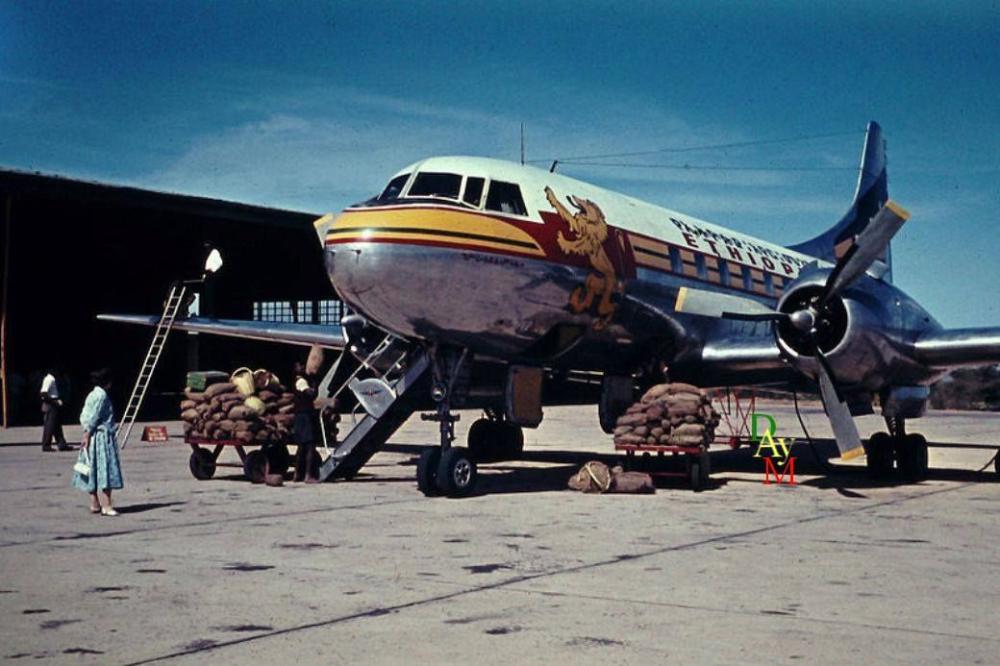
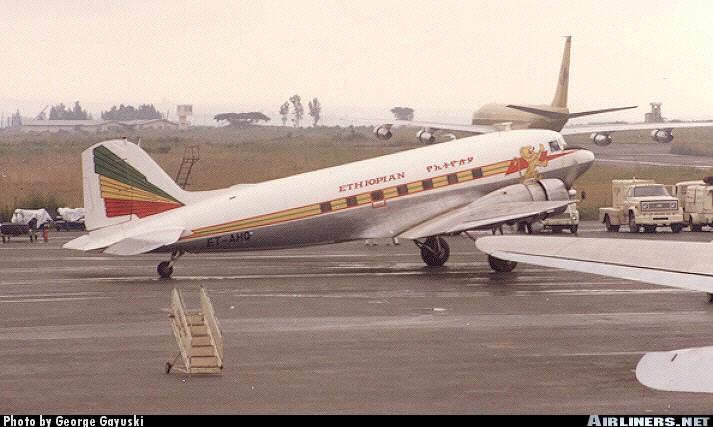
A new service to Athens via Khartoum and Wadi Halfa was launched on 3 April 1954. A third Convair CV-240 was purchased from Sabena in 1955. The carrier was in need of newer and larger aircraft. Two Douglas DC-6Bs were eventually ordered in 1956, including spares, an option for a third machine was also taken.
In 1957, the airline had been asked to take a Lockheed L-749 that had been given as a gift to the Emperor, who declined it. Ethiopian incorporated it into the fleet on 4 June 1957. On 21 Jun, the route to Athens was extended both to the north and to the south so that Frankfurt and Nairobi became linked by the same corridor, operated with DC-6Bs. By this time, the Convairs were redeployed to serve domestic and regional routes.
During 1959 two Boeing 720Bs were ordered and scheduled for delivery in December 1961, two more DC-6Bs entered the fleet, services to Nairobi were suspended once more and the airline's list of domestic destinations saw the incorporation of Bulchi, Dodollo, Lalibela and Masawa. Port Sudan was removed from the list of destinations on 1 March 1960.
The first East–West link made by an African airline started on 8 November, when the Addis Ababa–Accra–Lagos–Monrovia route was launched using DC-6B equipment. In March 1962, two more DC-3s were acquired, and registered. It was also decided to build a new airport to replace the Lideta Airfield, unable to accommodate the Boeing 720 jetliner the company intended to acquire. This was the birth of Bole International Airport, where the company set its headquarters.
In December 1962, the arrival of two Boeing 720s ordered directly from Boeing marked the carrier's entrance into the jet age. The first jet service took place on 15 January 1963 to Nairobi. The following day, a new service to Madrid was flown using the new jet equipment, with Frankfurt joining the jet network soon afterward. On 1 April, the Boeing 720 replaced the DC-6B on the Addis Ababa–Athens route; during that month, the West African corridor also benefited from jet operations.
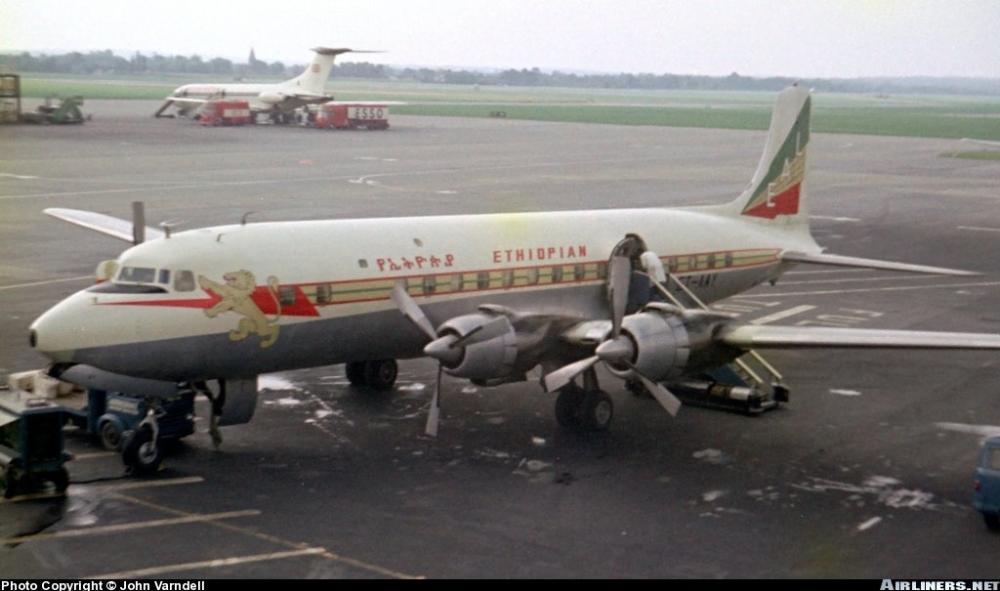
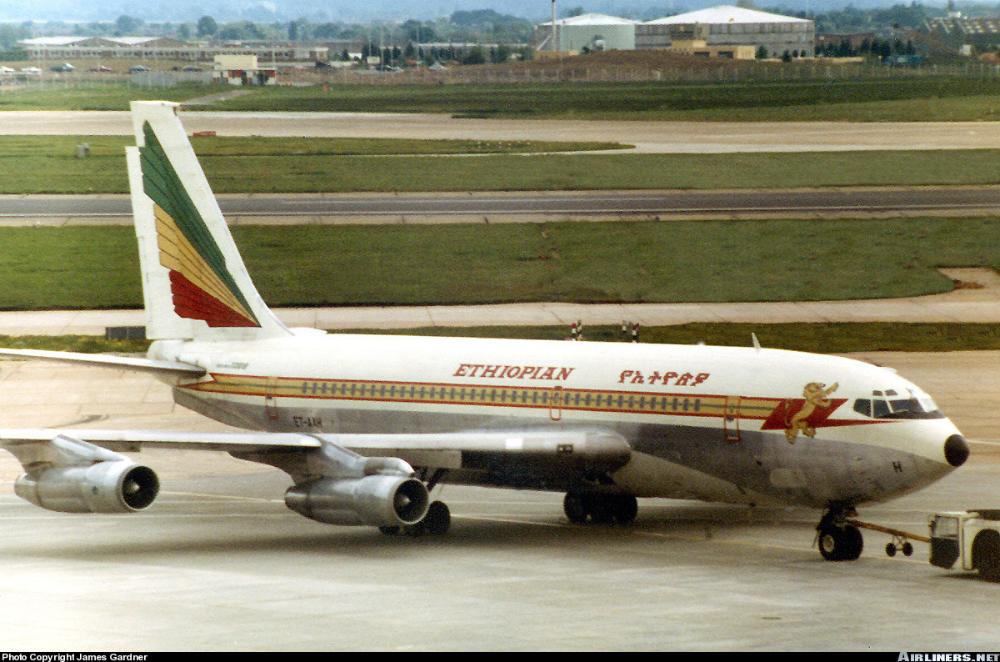
Also in the early 1960s, the carrier provided some initial aviation support to the Ethiopia-United States Mapping Mission in its operation to acquire topographic maps of Ethiopia. The firm changed from a corporation to a share company in 1965, and changed its name from Ethiopian Air Lines to Ethiopian Airlines.
By 1966, the contractual relationship with TWA was adjusted to reflect the transfer of management with the appointment of an Ethiopian deputy general manager. Two Boeing 720s were in operation and a Boeing 707-320C was due to be phased in by March 1968, when the carrier ordered a second -320C.
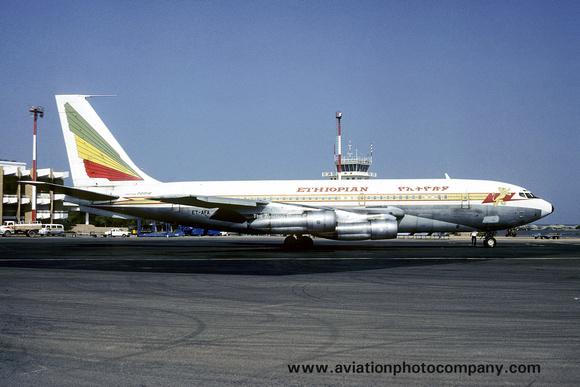
In 1970, the fifth renewal of the original 1945 contract changed TWA's role from manager to adviser. On its 25th anniversary in 1971, the company was ready to continue without foreign assistance. Since then, Ethiopian Airlines has been managed and staffed by Ethiopian personnel. Two Boeing 720Bs were acquired from Continental Airlines in 1973. In 1975, the carrier ordered five Dash 7s.
Ethiopian Airlines had became a new customer for the Boeing 727 in 1978, ordering two. The 727s arrived in 1979 as a replacement for the oldest Boeing 720s.
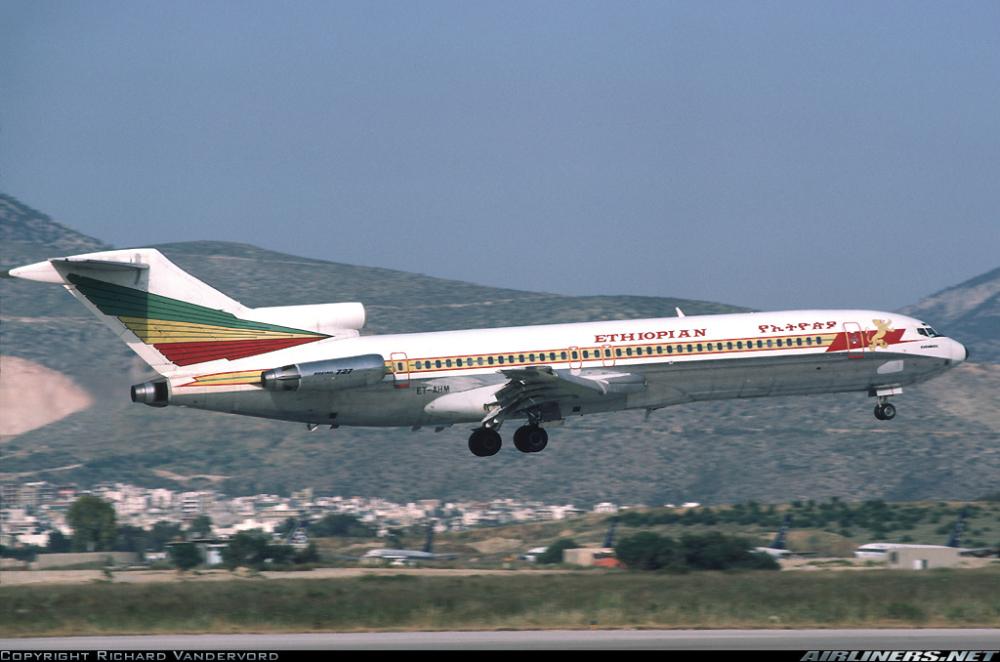
The DHC-5 Buffalo entered Ethiopian's fleet in the early 1980s. In 1982, Ethiopian became the first African carrier in ordering the Boeing 767, as well as the first airline to order the Boeing 767-200ER. They came to replace the remaining Boeing 720s. Ethiopian Airlines attracted worldwide attention on 1st June 1984 when its first Boeing 767 landed at Bole after a thirteen-and-a-half hour delivery flight from New York - setting a new world distance record for a commercial twin-engine jet. The airline, which was a launch customer for the new aircraft. At the end of 1985, when the DC-3/Skytrains started to be withdrawn, the airline still had nine of these in service, all of them at least 40 years old. The last of these aircraft remained in service until October, 1991.
ATR-42s and Twin Otters were incorporated into the fleet in the mid-1980s, with the first of six Twin Otters entering the fleet in early 1985. The Boeing 737-200 joined the fleet in late 1987.
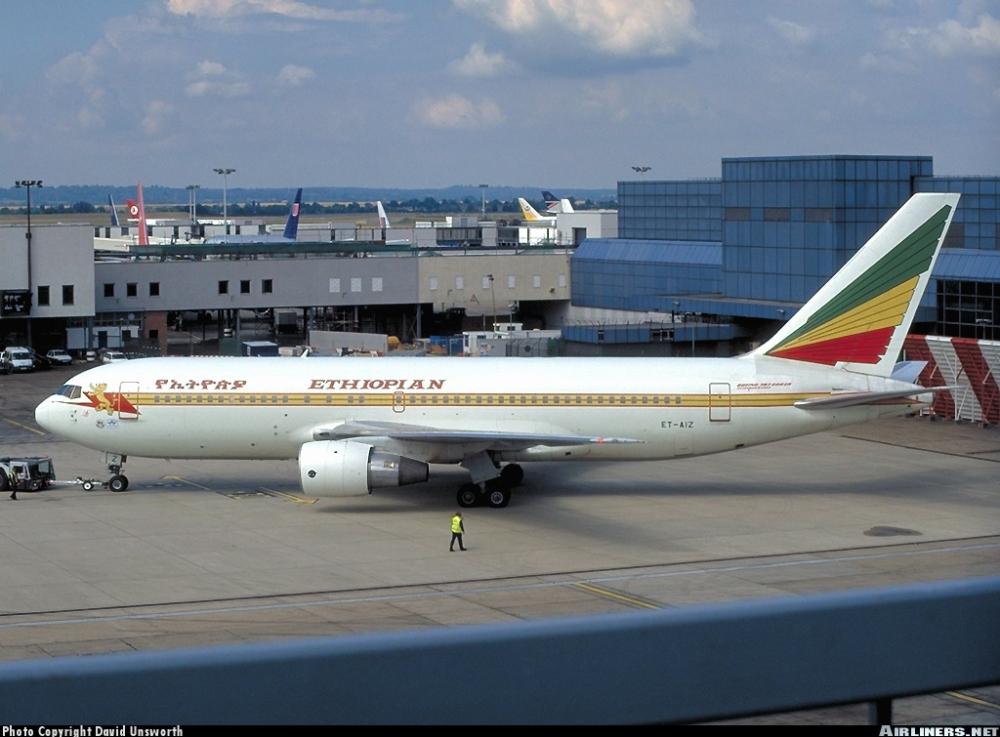
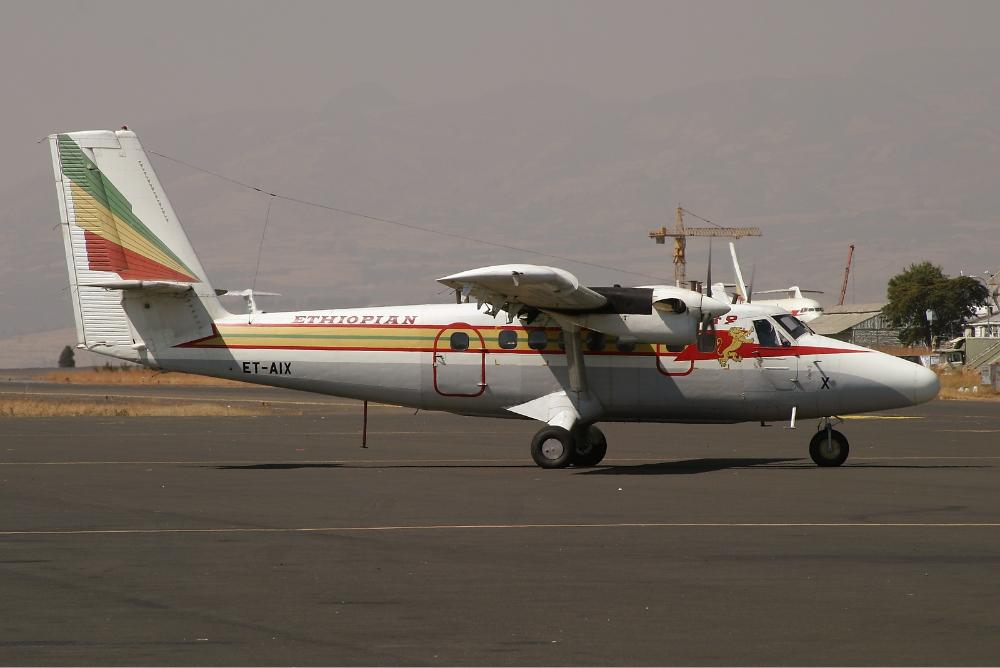
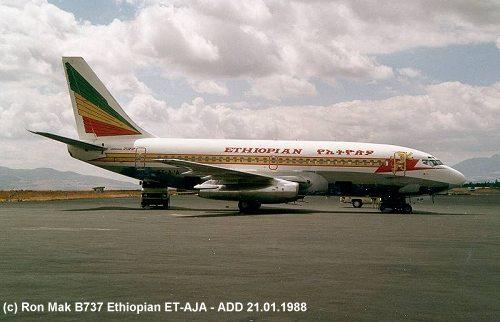
In 1990, Ethiopian became the first passenger airline in taking delivery of the Boeing 757 Freighter, receiving the first of five Boeing 757-200s a year later.
By 1996 the airline was flying to Bangkok, Beijing, Durban and Johannesburg; routes to Ivory Coast and Senegal were also being operated. Furthermore, the Fokker 50 entered the fleet to operate domestic routes In the late 1990s the carrier saw the incorporation of Copenhagen and Maputo to its international network, as well as New York City and Washington as transatlantic destinations. The frequent flyer programme, named "Sheba Miles" after the legendary Queen of Sheba, was launched too.
.jpg)
A fleet renewal started in the early 2000s, with the incorporation of the Boeing 737– 700 and the Boeing 767-300ER. The airline discontinued its service to Newark in favour of serving Washington in 2004. In 2009 Ethiopian ordered 35 new airplanes direct from the manufacturers. Including the orders of five B777-200LR and twelve A350-900, Ethiopian announced it would be the launch customer of the Boeing 787 Dreamliner, placing an order ten Boeing B787 and eight Bombardier aircrafts.
Ethiopian received three Boeing 777-200LLRs in 2011 increasing the total number of 777-200LRs to five.Ethiopian started new services to Hangzhou-China, to Malakal-Southern Sudan, Milan-Italy, Muscat-Oman. Ethiopian also launched daily nonstop flights to Beijing with its long range B777-200.
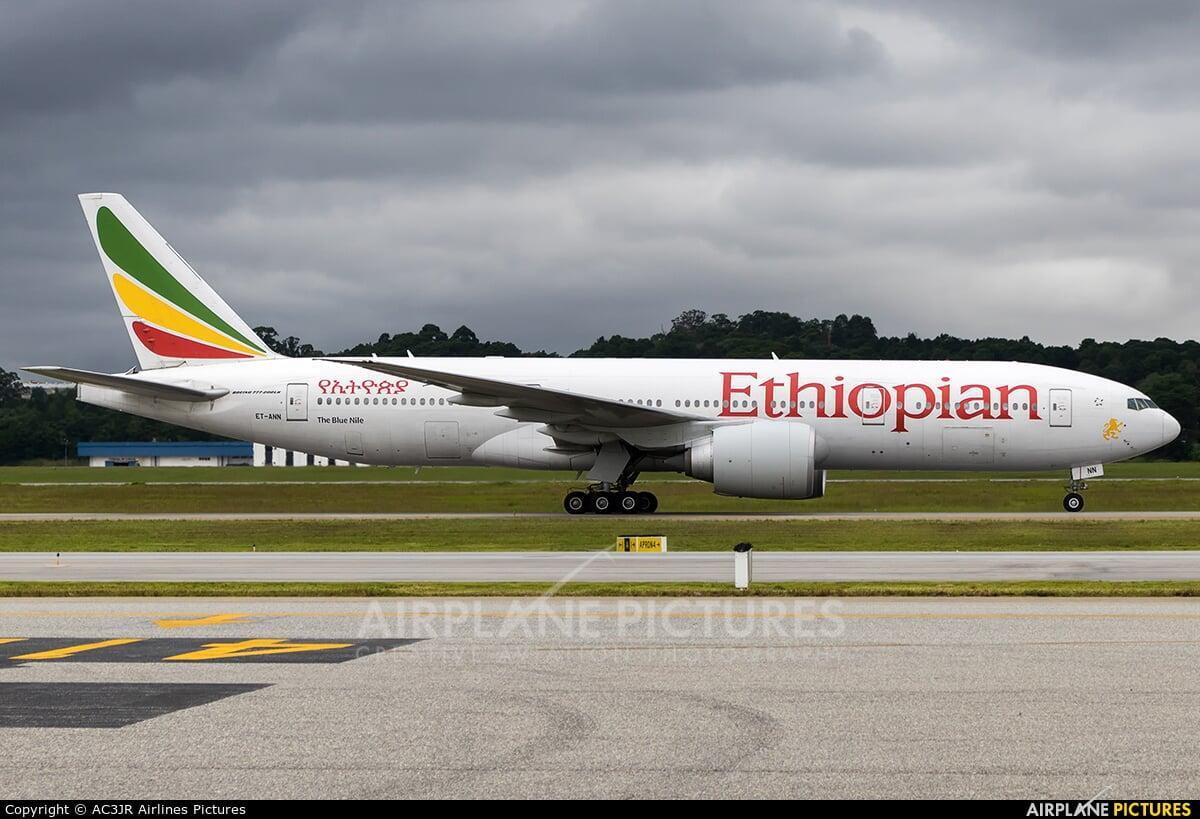
In late September 2010, Ethiopian Airlines was officially invited to join Star Alliance under the mentoring of Lufthansa. The carrier became a member of the alliance in December 2011, the third Africa-based carrier in doing so.
Ethiopian took delivery of its first Boeing 787 Dreamliner on August 14, 2012 in Seattle, Washington. Ethiopian took another leap forward by receiving its second Boeing 787 Dreamliner October 3, 2012. Ethiopian takes delivery of the second 737-800 Sky Interior Aircraft. Ethiopian started new services to Toronto-Canada and Berbera, the port city of Somaliland. Ethiopian also increased frequencies on its Abidjan route by offering daily flights.
During 2012, Ethiopian takes delivery of the first of its five re-configured Bombardier Q-400 aircraft. and places firm orders for five more Q400 NextGen aircrafts.
In 2013 Ethiopian started new services to Blantyre, Ndola, Seoul, Enugu-Nigeria, Sao Paulo, Rio de Janeiro, Niamey-Niger, Singapore, Semere-Ethiopia. The airline received brand new next generation Boeing 737-800 with Sky Interior. It received its sixth Boeing 777-200LR Worldliner and took delivery of its first B777-300ER leased from Boeing.
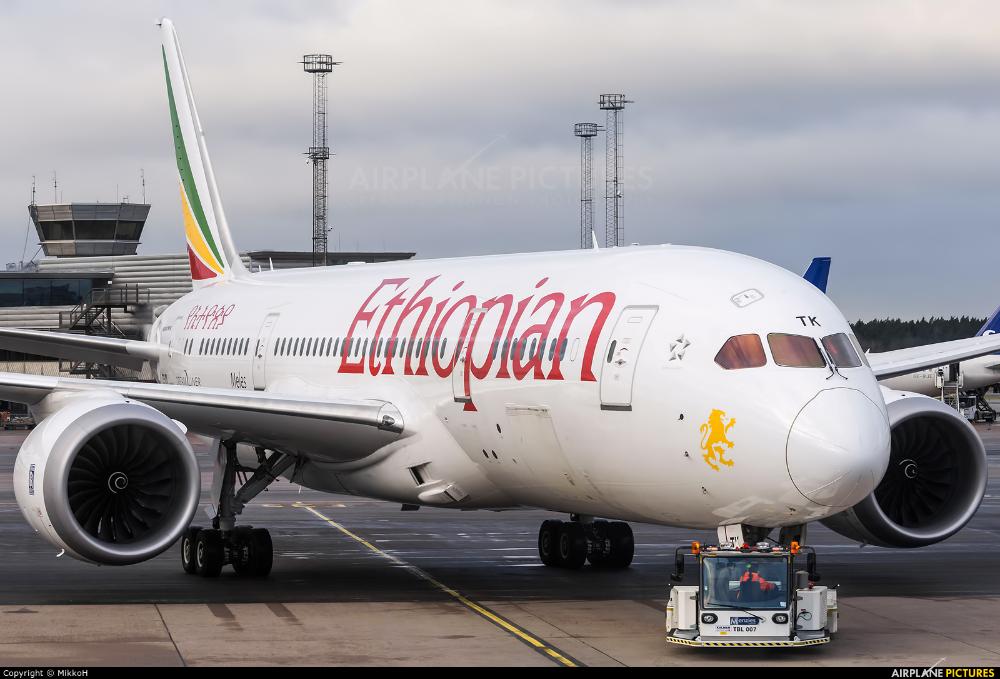
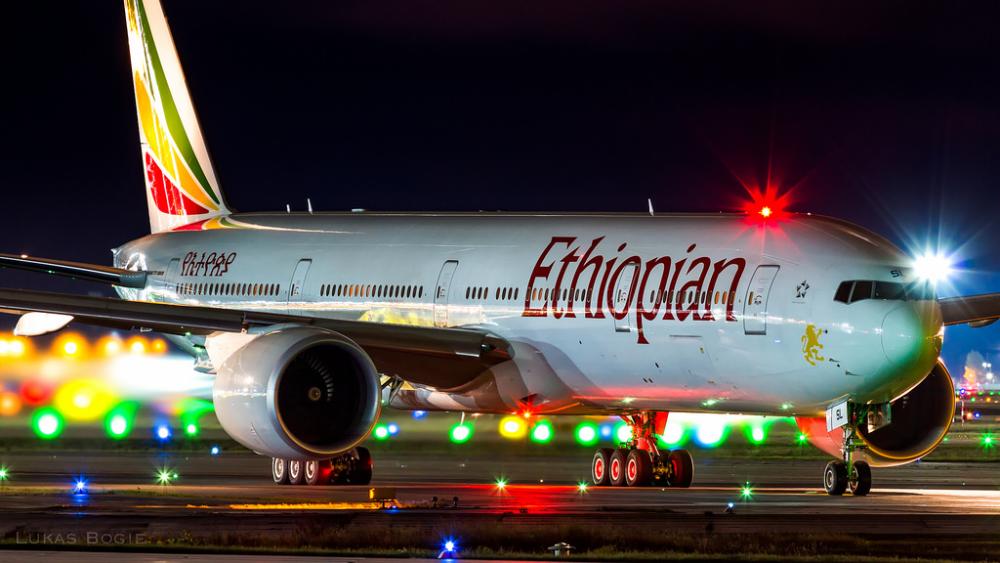
In 2014, Ethiopian started new services to Doha-Qatar, Vienna-Austria, Kano-Nigeria, Shanghai-China, Bale Robe & Kombolcha -Ethiopia. Ethiopian also launched four daily flights to Nairobi and daily flights to London. Also in 2014 Ethiopian received four more Boeing 787 in 2014 increasing the total number of B787 to ten. Ethiopian Airlines ordered 20 737 MAX 8s from Boeing.
It started new flights in 2015 to Cape Town (South Africa), Gaborone (Botswana), Los Angeles (USA), Dublin (Ireland), Goma (Dem. Rep. of Congo), Tokyo (Japan), Manila (Philippines), Yaounde (Cameroon), Sao Paulo (Brazil) and new cargo destination to Bengaluru (India).
In 2016, Ethiopian is the 1st Airline in Africa to Receive the Airbus A350-900 and first in the World to fly it in African Skies. The Airbus 350 made its debut flight to Ethiopian destinations including: Yaoundé Cameroon, Kigali,Nairobi, Lagos, Bujumbura, London Heathrow, Douala, Malabo, Southern Africa, Lusaka, Harare, N’Djamena and Entebbe. Also the Addis Ababa–Lomé–Newark flight was to resume in July 2016.
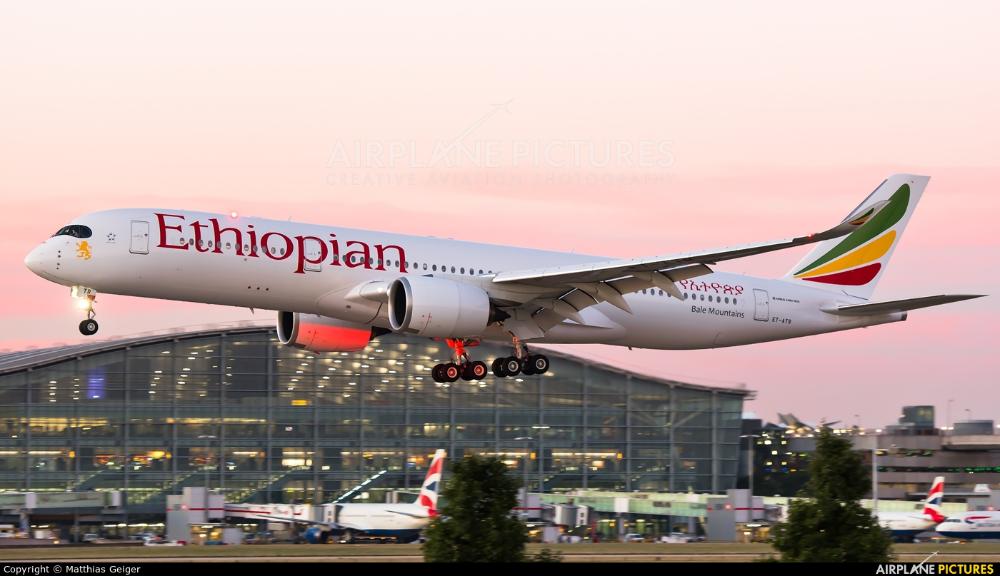
At the 2017 Paris Airshow, Ethiopian announced an additional firm order for 10 Airbus A350-900s. The airline also exercised its options for 10 Boeing 737 MAX 8s they had from their original order in 2014. In October 2017, the airline took delivery of its first Boeing 787-9 Dreamliner. Buenos Aires became the second stop for the airline in the South American continent starting on March 8, 2018 as an addition to the existing Addis Ababa-São Paulo flight.
Later in 2018, Ethiopian Airlines placed a repeat order for the Bombardier Q400 turboprop aircraft. The airline took delivery of its first Boeing 737 MAX 8 in July 2018.
History source: Wikipedia.org + Ethiopianairlines.com
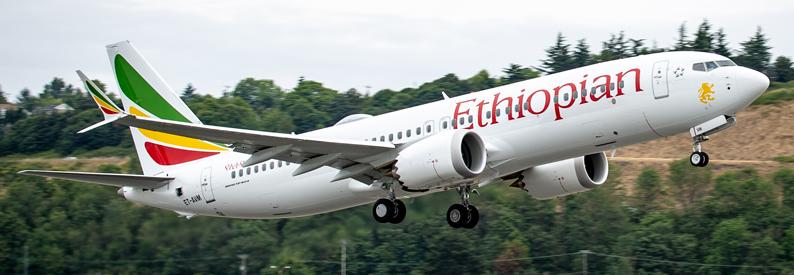
Operations and Destinations 🌍:
As of November 2017, the carrier serves 105 international and 20 domestic passenger destinations. Ethiopian serves more destinations in Africa than any other airline. It has embarked on a substantial growth programme since 2011, adding many more destinations and making Addis Ababa a major transit hub in the African Continent. The African Airline is now one of the most respected and solid airlines in the continent and has won many awards and recognitions for its work, social investment and expansion.
The Airport at Addis Ababa, Bole International Airport, is in the process of being upgraded as it already has reached maximum capacity. It is the airline's main hub where it flies to the following destinations*:
| Region 🗺️ | Destinations 🌍🌎🌏 |
|---|---|
| ✈Ethiopia (domestic) | Addis Ababa, Arba Minch, Asosa, Awasa, Axum, Bahar Dar, Dembidolo, Dessie, Dire Dawa, Gambela, Goba, Gode, Gondar, Humera, Jijiga, Jimma, Kebri Dahar, Lalibela, Mekele, Semera |
| ✈Africa | Abidjan, Abuja, Addis Ababa, Accra, Antananarivo, Asmara,Bahir Dar, Bamako, Blantyre, Brazzaville, Bujumbura, Cairo, Cape Town, Comoros Moroni, Conakry, Cotonou, Dakar, Dar -es- Salaam, Dire Dawa, Djibouti, Douala, Durban, Entebbe, Enugu, Gaborone, Goma, Harare, Hargessa , Johannesburg, Juba, Kaduna, Kano, Khartoum, Kigali, Kilimanjaro, Kinshasa, Kisangani, Lagos, Libervile, Lilongwe, Lome, Luanda, Lubumbashi, Lusaka, Malabo, Maputo, Mbuji-Mayi, Mombasa, Nairobi, Ndola, Niamey, Nosi Be, N'djamena, Ouagadougou, Pointe Noire, Seychelles, Victoria Falls, Windhoek, Yaounde, Zanzibar |
| ✈The Middle East | Bahrain , Beirut, Dammam, Dubai, Dubai Al-Maktoum, Doha, Jeddah, Kuwait, Madinah, Muscat, Riyadh, Sharjah, Tel Aviv |
| ✈Europe and Russia | Barcelona, Brussels, Dublin, Frankfurt, Geneva, Istanbul, London, Madrid, Manchester, Milan, Moscow, Oslo, Paris, Rome, Stockholm, Vienna |
| ✈Asia | Ahmedabad, Bangkok, Bangalore, Beijing, Delhi, Chennai /Madras, Chengdu, Guangzhou, Hanoi, Hong Kong, Jakarta, Kuala Lumpur, Manila, Mumbai, Narita- Tokyo, Seoul, Shanghai, Singapore |
| ✈North and South America | Buenos Aires, Chicago, Los Angeles, Newark, Sao-Paulo, Toronto, Washington Dc |
*Destination list is for reference only. Please check directly with the airline for updates.
*Note some destinations are only seasonal.*Correct info as of Nov 2018.
Fleet ✈️:
The airline has come a long way in the last decade to upgrade it's fleet and products. Making it a premium airline in the African Continent to fly to/from and transit. It's fleet consists of one of the youngest and most modern fleets in Africa with a very reliable workforce. In total Ethiopian Airlines has a fleet or more than 110 aircraft.
The fleet* currently consists of the following aircraft:
| Network 🌐 | Aircraft ✈️ |
|---|---|
| ✈Domestic and Regional | Bombardier Dash 8 Q400, Boeing 737-700/800, (B737-Max8) |
| ✈Short and Medium Haul | Boeing 737-800, B767-300ER, B777-200, B777-300ER, B787-8 |
| ✈Long Haul | Boeing 777-300ER, B787-8/9. Airbus A350-900 |
*Correct fleet info as of Nov 2018.
Ethiopian Airlines Photo Slide 📷:
Reviews ⭐:
 |  |
|---|---|
| ✅Member of the Star Alliance for millage redemption | 👎Connection facilities in Addis Ababa are in need of upgrade. Overcrowded Airport. |
| ✅One of youngest and most modern fleets in Africa. | 👎Missed-connections by flight delays are poorly organised. |
| ✅ Best Airline to fly to Africa | |
| ✅ Good connection times in Addis Ababa | |
| ✅ Baggage and meals included within the ticket. | |
| ✅Friendly service and a good English speaking crew. |

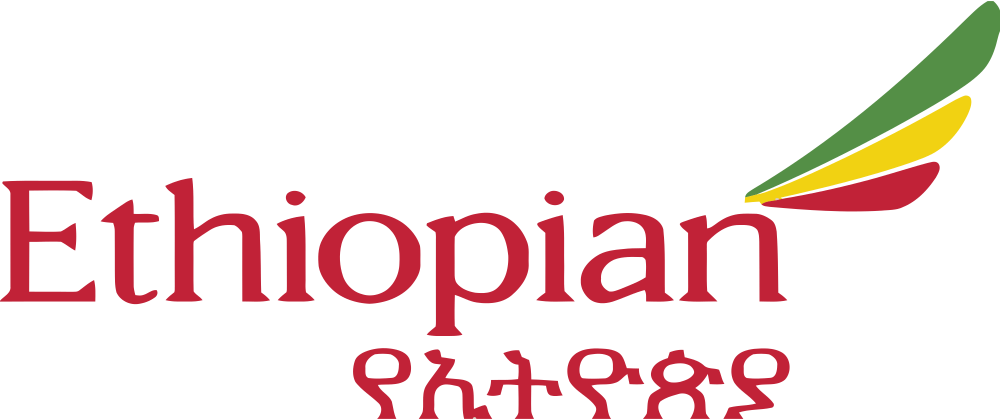


















.png)